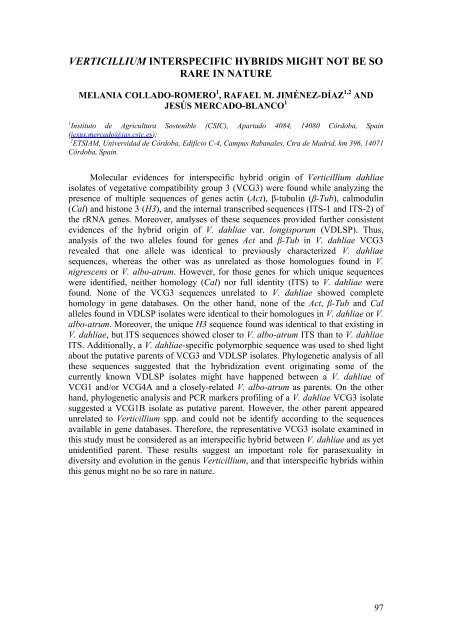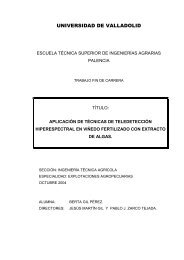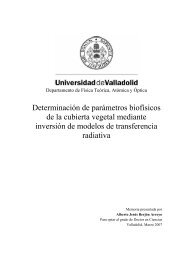10th INTERNATIONAL VERTICILLIUM SYMPOSIUM 16-20 ...
10th INTERNATIONAL VERTICILLIUM SYMPOSIUM 16-20 ...
10th INTERNATIONAL VERTICILLIUM SYMPOSIUM 16-20 ...
Create successful ePaper yourself
Turn your PDF publications into a flip-book with our unique Google optimized e-Paper software.
<strong>VERTICILLIUM</strong> INTERSPECIFIC HYBRIDS MIGHT NOT BE SORARE IN NATUREMELANIA COLLADO-ROMERO 1 , RAFAEL M. JIMÉNEZ-DÍAZ 1,2 ANDJESÚS MERCADO-BLANCO 11 Instituto de Agricultura Sostenible (CSIC), Apartado 4084, 14080 Córdoba, Spain(jesus.mercado@ias.csic.es);2 ETSIAM, Universidad de Córdoba, Edificio C-4, Campus Rabanales, Ctra de Madrid, km 396, 14071Córdoba, Spain.Molecular evidences for interspecific hybrid origin of Verticillium dahliaeisolates of vegetative compatibility group 3 (VCG3) were found while analyzing thepresence of multiple sequences of genes actin (Act), β-tubulin (β-Tub), calmodulin(Cal) and histone 3 (H3), and the internal transcribed sequences (ITS-1 and ITS-2) ofthe rRNA genes. Moreover, analyses of these sequences provided further consistentevidences of the hybrid origin of V. dahliae var. longisporum (VDLSP). Thus,analysis of the two alleles found for genes Act and β-Tub in V. dahliae VCG3revealed that one allele was identical to previously characterized V. dahliaesequences, whereas the other was as unrelated as those homologues found in V.nigrescens or V. albo-atrum. However, for those genes for which unique sequenceswere identified, neither homology (Cal) nor full identity (ITS) to V. dahliae werefound. None of the VCG3 sequences unrelated to V. dahliae showed completehomology in gene databases. On the other hand, none of the Act, β-Tub and Calalleles found in VDLSP isolates were identical to their homologues in V. dahliae or V.albo-atrum. Moreover, the unique H3 sequence found was identical to that existing inV. dahliae, but ITS sequences showed closer to V. albo-atrum ITS than to V. dahliaeITS. Additionally, a V. dahliae-specific polymorphic sequence was used to shed lightabout the putative parents of VCG3 and VDLSP isolates. Phylogenetic analysis of allthese sequences suggested that the hybridization event originating some of thecurrently known VDLSP isolates might have happened between a V. dahliae ofVCG1 and/or VCG4A and a closely-related V. albo-atrum as parents. On the otherhand, phylogenetic analysis and PCR markers profiling of a V. dahliae VCG3 isolatesuggested a VCG1B isolate as putative parent. However, the other parent appearedunrelated to Verticillium spp. and could not be identify according to the sequencesavailable in gene databases. Therefore, the representative VCG3 isolate examined inthis study must be considered as an interspecific hybrid between V. dahliae and as yetunidentified parent. These results suggest an important role for parasexuality indiversity and evolution in the genus Verticillium, and that interspecific hybrids withinthis genus might no be so rare in nature.97




